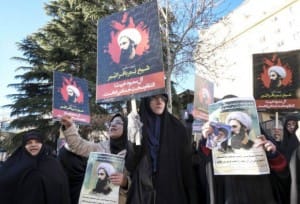
The United States shouldn’t take sides in the Sunni-Shiite struggle
 Iranian women hold a poster of executed Shiite cleric Nimr al-Nimr during a protest against Saudi Arabia in Tehran.
Iranian women hold a poster of executed Shiite cleric Nimr al-Nimr during a protest against Saudi Arabia in Tehran.
Over the past two decades, the United States has approached the Middle East through its own conceptual frameworks: dictatorships vs. democracy, secularism vs. religion, order vs. chaos. But the most significant trend shaping the region today is something different: Sunnis vs. Shiites. That sectarian struggle now infects almost every aspect of the region’s politics. It has confounded U.S. foreign policy and will continue to limit the ability of the United States, or any outside power, to stabilize the region.
In his prescient book, “The Shia Revival,” Vali Nasr argues that the U.S. invasion of Iraq in 2003 was the tipping point. The United States saw itself as taking democracy to Iraq, but people in the region saw something different — the upending of the balance of power. Sunnis, who make up 85 percent of all Muslims, had long dominated the Arab world, even in Shiite-majority countries such as Iraq and Bahrain. But in one stroke, that changed. Iraq, a major Arab state, would now be ruled by Shiites. This rattled other Arab regimes, and their anxieties have only grown.
Though there always was tension, Sunnis and Shiites did live in peace, for the most part, until recently. In the 1960s and ’70s, the only Shiite power, Iran, was ruled by the shah, whose regime was neither religious nor sectarian. In fact, when the shah was overthrown, the country that first gave him safe harbor was Egypt, the region’s largest Sunni power, something unimaginable in today’s sectarian atmosphere.
The pivotal shift took place in 1979. The Islamic Revolution in Iran brought to power an aggressively religious ruling class, determined to export its ideas and support Shiites in the region. That same year, in Saudi Arabia, militant radicals took over the Grand Mosque in Mecca, proclaiming opposition to the royal family and what they saw as its lax ways. The event scared the Saudis, pushing the regime substantially to the religious right. And Saudi Arabia’s governing ideology of Wahhabi Islam was always anti-Shiite. Around the time of its founding, Saudi Arabia demolished Shiite mosques and shrines and spread its view that Shiites are heretics.
As Iran has expanded its influence in Lebanon, Iraq and Syria, Saudi Arabia has responded by adopting an even more sectarian edge. A decade ago, Saudi officials spoke of the need to include and empower the country’s Shiite minority. Today Saudi Shiites are viewed with suspicion, seen by some as agents of Iran.
Saudi Arabia and Iran have held long-running suspicions and outright hostility towards each other. Here’s why. (The Washington Post)
In Yemen, a civil war has become a sectarian one. In a report for the Carnegie Endowment for International Peace, Farea al-Muslimi points out that now the two sides in Yemen refer to each other as “Persians” and “Daeshites” (coming from the Arab acronym for ISIS, or the Islamic State). Al-Muslimi writes that “sectarian discourse has become more heated, reorganizing Yemeni society along sectarian lines and rearranging people’s relationships to one another on a non-nationalist basis.”
Saudi Arabia has real strategic concerns about Iran’s influence, especially in Iraq. As Ali al Shihabi, a Saudi banker-turned-writer, said to me, “Southern Iraq is full of Iranian-backed militias. That’s just a two-hour drive from Saudi Arabia’s oil fields. The kingdom has to be worried.” But the policy of sectarian warfare may be about more than simply geopolitics. Saudi Arabia is facing a series of challenges, from the Islamic State to domestic extremists. The country’s large and active social media are dominated by radical Islamists. And as oil prices plunge, government revenue has collapsed, and the nation’s generous subsidies to its people will be hard to sustain. The regime needs greater legitimacy.
Add up last weekend’s execution of a prominent Shiite cleric, the break with Iran, the war in Yemen and Saudi policy toward Syria, and you see a more assertive, aggressive and sectarian foreign policy than Saudi Arabia has ever pursued. The strategy is not without risks, external and internal. About 10 to 15 percent of Saudi Arabians are Shiites, and they live in the Eastern Province, atop the kingdom’s oil fields. Neighboring Bahrain and Yemen are now filled with resentful Shiites, who see Saudi Arabia as repressing them. And Iran will surely react to Saudi actions over time.
In general, the United States should support Saudi Arabia in resisting Iran’s encroachments in the region, but it should not take sides in the broader sectarian struggle. This is someone else’s civil war. After all, Washington’s principal ally in the fight against the Islamic State is the Shiite-dominated government in Baghdad. And besides, the single greatest threat to the United States emanating from the Middle East remains radical Sunni jihadists — many of whom have drawn inspiration, funding and doctrine from Saudi Arabia.
There are very few good guys in this story.